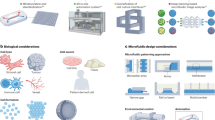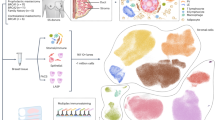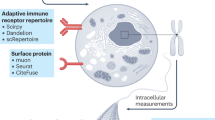Abstract
Rapid and accurate measurement of biomarkers in tissue and fluid samples is a major challenge in medicine. Here we report the development of a new, miniaturized diagnostic magnetic resonance (DMR) system for multiplexed, quantitative and rapid analysis. By using magnetic particles as a proximity sensor to amplify molecular interactions, the handheld DMR system can perform measurements on unprocessed biological samples. We show the capability of the DMR system by using it to detect bacteria with high sensitivity, identify small numbers of cells and analyze them on a molecular level in real time, and measure a series of protein biomarkers in parallel. The DMR technology shows promise as a robust and portable diagnostic device.
This is a preview of subscription content, access via your institution
Access options
Subscribe to this journal
Receive 12 print issues and online access
$209.00 per year
only $17.42 per issue
Buy this article
- Purchase on Springer Link
- Instant access to full article PDF
Prices may be subject to local taxes which are calculated during checkout




Similar content being viewed by others
References
Cheng, M.M.-C. et al. Nanotechnologies for biomolecular detection and medical diagnostics. Curr. Opin. Chem. Biol. 10, 11–19 (2006).
Wulfkuhle, J.D., Liotta, L.A. & Petricoin, E.F. Proteomic applications for the early detection of cancer. Nat. Rev. Cancer 3, 267–275 (2003).
Hood, L., Heath, J.R., Phelps, M.E. & Lin, B. Systems biology and new technologies enable predictive and preventative medicine. Science 306, 640–643 (2004).
Schroder, L., Lowery, T., Hilty, C., Wemmer, D. & Pines, A. Molecular imaging using a targeted magnetic resonance hyperpolarized biosensor. Science 314, 446–449 (2006).
Zheng, G., Patolsky, F., Cui, Y., Wang, W. & Lieber, C. Multiplexed electrical detection of cancer markers with nanowire sensor arrays. Nat. Biotechnol. 23, 1294–1301 (2005).
Nam, J.M., Thaxton, C. & Mirkin, C. Nanoparticle-based bio-bar codes for the ultrasensitive detection of proteins. Science 301, 1884–1886 (2003).
Aslan, K., Lakowicz, J.R. & Geddes, C.D. Plasmon light scattering in biology and medicine: new sensing approaches, visions and perspectives. Curr. Opin. Chem. Biol. 9, 538–544 (2005).
Aebersold, R. & Mann, M. Mass spectrometry–based proteomics. Nature 422, 198–207 (2003).
Sidransky, D. Emerging molecular markers of cancer. Nat. Rev. Cancer 2, 210–219 (2002).
Perez, J.M., Josephson, L., O'Loughlin, T., Hogemann, D. & Weissleder, R. Magnetic relaxation switches capable of sensing molecular interactions. Nat. Biotechnol. 20, 816–820 (2002).
Nair, P.R. & Alam, M.A. Performance limits of nanobiosensors. Appl. Phys. Lett. 88, 233120–233123 (2006).
Peck, T.L., Magin, R.L. & Lauterbur, P.C. Design and analysis of microcoils for NMR microscopy. J. Magn. Reson. B. 108, 114–124 (1995).
Massin, C. et al. Planar microcoil-based microfluidic NMR probes. J. Magn. Reson. 164, 242–255 (2003).
Trumbull, J.D., Glasgow, I.K., Beebe, D.J. & Magin, R.L. Integrating microfabricated fluidic systems and NMR spectroscopy. IEEE Trans. Biomed. Eng. 47, 3–7 (2000).
Lee, H., Liu, Y., Westervelt, R.M. & Ham, D. IC/microfluidic hybrid system for magnetic manipulation of biological cells. IEEE J. Solid-State Circuits 41, 1471–1480 (2006).
Xia, H.M., Wan, S.Y.M., Shu, C. & Chew, Y.T. Chaotic micromixers using two-layer crossing channels to exhibit fast mixing at low Reynolds numbers. Lab Chip 5, 748–755 (2005).
Koh, I., Hong, R., Weissleder, R. & Josephson, L. Sensitive NMR sensors detect antibodies to influenza. Angew. Chem. Int. Ed. Engl. 47, 4119–4121 (2008).
Olson, D.L., Peck, T.L., Webb, A.G., Magin, R.L. & Sweedler, J.V. High-resolution microcoil 1H-NMR for mass-limited, nanoliter-volume samples. Science 270, 1967–1970 (1995).
Boero, G., de Raad Iseli, C., Besse, P.A. & Popovic, R.S. An NMR magnetometer with planar microcoils and integrated electronics for signal detection and amplification. Sens. Actuators A 67, 18–23 (1998).
Lee, J.H. et al. Artificially engineered magnetic nanoparticles for ultra-sensitive molecular imaging. Nat. Med. 13, 95–99 (2007).
Halbach, K. Design of permanent multipole magnets with oriented rare earth cobalt material. Nucl. Instrum. Methods 169, 1–10 (1980).
Perlo, J., Casanova, F. & Blumich, B. Ex situ NMR in highly homogeneous fields: 1H spectroscopy. Science 315, 1110–1112 (2007).
Dittrich, P.S. & Manz, A. Lab-on-a-chip: microfluidics in drug discovery. Nat. Rev. Drug Discov. 5, 210–218 (2006).
Urdea, M. et al. Requirements for high impact diagnostics in the developing world. Nature 444 (suppl. 1), 73–79 (2006).
Barna, J.C. & Williams, D.H. The structure and mode of action of glycopeptide antibiotics of the vancomycin group. Annu. Rev. Microbiol. 38, 339–357 (1984).
Keeler, E. et al. Reducing the global burden of tuberculosis: the contribution of improved diagnostics. Nature 444 (suppl. 1), 49–57 (2006).
Ricci, K.A. et al. Reducing stunting among children: the potential contribution of diagnostics. Nature 444 (suppl. 1), 29–38 (2006).
Lim, Y.W. et al. Reducing the global burden of acute lower respiratory infections in children: the contribution of new diagnostics. Nature 444 (suppl. 1), 9–18 (2006).
Cristofanilli, M. et al. Circulating tumor cells, disease progression and survival in metastatic breast cancer. N. Engl. J. Med. 351, 781–791 (2004).
Liu, Y., Sun, N., Lee, H., Weissleder, R. & Ham, D. CMOS mini nuclear magnetic resonance system and its application for biomolecular sensing. ISSCC Dig. Tech. Papers 1, 140–141 (2008).
Acknowledgements
The authors gratefully acknowledge N. Sergeyev for synthesizing CLIO, K. Kelly, K. Kristof and S. Thomas for cell culture and I. Koh for help in magnetic microparticle–based assay. We especially thank L. Josephson, J. Bradner and M. Cima for many helpful suggestions, R.M. Westervelt for generous support in device fabrication and D.S. Yun and A. Belcher for assistance in imaging bacteria with a transmission electron microscope.
Author information
Authors and Affiliations
Contributions
H.L. designed the device, built the DMR prototype, obtained measurements, analyzed data and wrote the manuscript. E.S. performed all chemical modifications of magnetic nanoparticles and assisted in measurements and data analysis. D.H. collaborated in the development of the NMR electronics of discrete components. R.W. conceived the project, provided overall guidance, designed experiments and targeted nanoparticles, analyzed the data and wrote the manuscript with contributions from all authors.
Corresponding author
Ethics declarations
Competing interests
R.W. is a shareholder of T2 Biosystems. H.L., D.H. and R.W. are listed on a patent application to the US Patent Office filed by Harvard University and Massachusetts General Hospital.
Supplementary information
Supplementary Text and Figures
Supplementary Figs. 1–5, Supplementary Tables 1–5 and Supplementary Methods (PDF 3354 kb)
Rights and permissions
About this article
Cite this article
Lee, H., Sun, E., Ham, D. et al. Chip–NMR biosensor for detection and molecular analysis of cells. Nat Med 14, 869–874 (2008). https://doi.org/10.1038/nm.1711
Received:
Accepted:
Published:
Issue Date:
DOI: https://doi.org/10.1038/nm.1711
This article is cited by
-
Order–order assembly transition-driven polyamines detection based on iron−sulfur complexes
Communications Chemistry (2023)
-
Highly stable integration of graphene Hall sensors on a microfluidic platform for magnetic sensing in whole blood
Microsystems & Nanoengineering (2023)
-
Story of Pore-Forming Proteins from Deadly Disease-Causing Agents to Modern Applications with Evolutionary Significance
Molecular Biotechnology (2023)
-
Electrochemical nanobiosensors equipped with peptides: a review
Microchimica Acta (2022)



